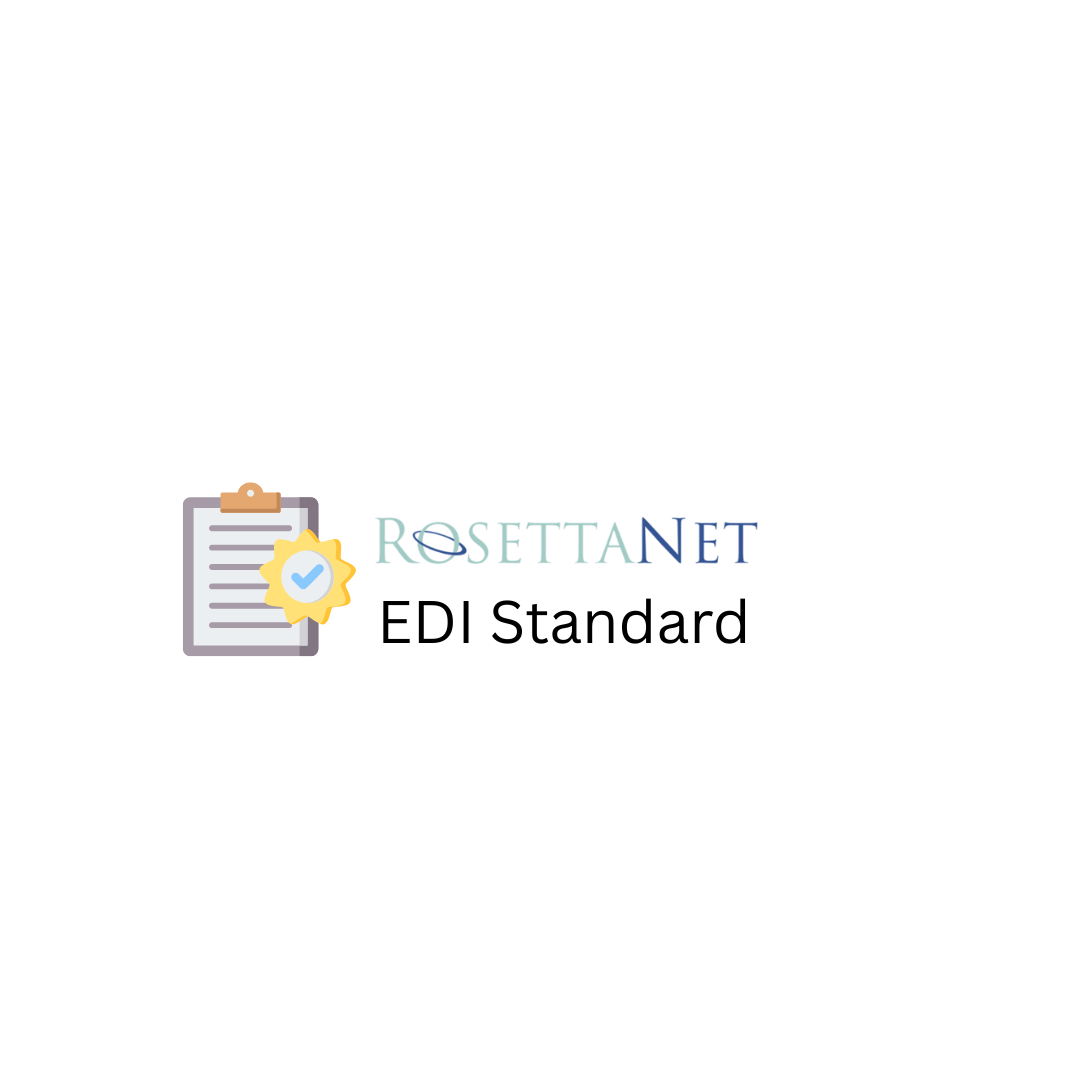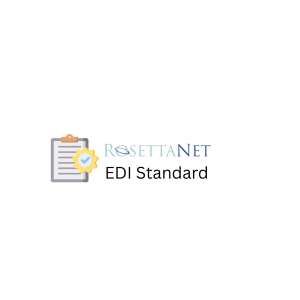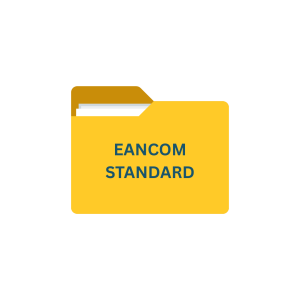Introduction
Over 300,000 companies worldwide rely on EDI standards for their daily transactions, making it essential to understand and implement these systems effectively. RosettaNet EDI standard, specifically designed for XML-based document exchanges, has become the backbone of electronic transactions in the semiconductor industry, consumer electronics, telecommunications, and logistics sectors.
Additionally, the RosettaNet Implementation Framework (RNIF) provides comprehensive guidelines for developing software applications, supporting multiple transport protocols like secure HTTP and SMTP for flexible message exchanges.
Understanding RosettaNet EDI Standard
RosettaNet emerged as a transformative force in B2B communications when established as a non-profit consortium in 1998. Unlike other EDI standards, RosettaNet was designed with a specific focus on creating standardized processes for sharing business information across supply chains.
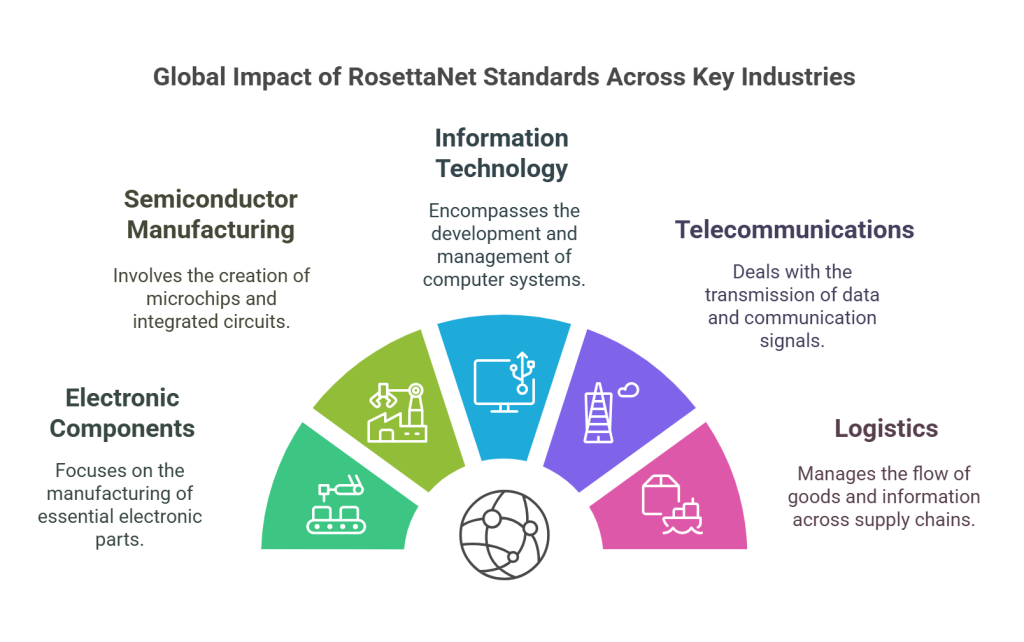
What is RosettaNet and how it differs from traditional EDI
RosettaNet represents a global standard for electronic B2B communication and collaboration specifically tailored for supply chain management. At its core, it includes standardized message formats, business processes, and implementation frameworks that facilitate electronic data exchange between trading partners. The RosettaNet Implementation Framework (RNIF) defines how to build, parse, secure, and transmit RosettaNet messages.
In contrast to traditional EDI standards, RosettaNet focuses intensely on process and process modeling. While traditional EDI standards lack process-focused messages (a strategic fault acknowledged by many), RosettaNet pioneered this approach to streamline business operations. Furthermore, the traditional EDI standards architecture was originally built around 24-hour batch processing, whereas RosettaNet delivers sub-minute response times for critical inter-organizational processes.
Key differences from traditional EDI include:
- RosettaNet is XML-based, while traditional EDI standards like X12 and EDIFACT are text-based
- RosettaNet created essential business and technical dictionaries that other EDI standards lack
- RosettaNet’s quality-of-service expectations enable reliable, near real-time responses
- Traditional EDI VAN activities are integrated into RosettaNet’s network architecture
- RosettaNet focuses heavily on process modeling, while other EDI standards does not
Perhaps most notably, RosettaNet developed two critical dictionaries: the RosettaNet Business Dictionary (RNBD) and the RosettaNet Technical Dictionary (RNTD). The RNBD defines business terms like “Purchase Order Acceptance” to ensure trading partners correctly map processes, while the RNTD ensures consistent product data exchange regardless of internal terminology preferences.
Industries adopting RosettaNet standards
Although RosettaNet standards can benefit various industries, they have gained traction in high-tech sectors. The standard is widely implemented in the global semiconductor industry and has been embraced by major computer and consumer electronics manufacturers.
The primary industries utilizing RosettaNet include:
- Electronic Components manufacturing
- Semiconductor Manufacturing
- Information Technology
- Telecommunications
- Logistics[13]
While RosettaNet originated in the United States and maintains strong adoption there, it has also gained significant acceptance in Asia, even receiving governmental support in some regions. In Europe, however, adoption has been slower due to the widespread use of EDIFACT, though growth continues.
Benefits of using RosettaNet in B2B integration
Organizations implementing RosettaNet standards experience numerous operational and financial advantages. The return on investment from early adopters demonstrated significant cost reductions and improved operational efficiencies..
RosettaNet delivers several key benefits:
- Time compression across organizational boundaries: Unlike other EDI standards, batch processing limitations, RosettaNet enables near real-time processing
- Machine-processable information: All RosettaNet components, including messages, dictionaries, and process definitions, can be processed by computers
- Common e-business language: Standards align processes between supply chain partners globally.
- Lower technical and financial barriers: RosettaNet enables global commerce for organizations of any size
- Enhanced collaboration: The RosettaNet Basics initiative drives B2B integration with mid-tier companies through baseline functionality for core PIPs
The RosettaNet standard continues to evolve to meet industry needs, with ongoing development of low-cost turnkey solutions to support implementation. Through Partner Interface Processes (PIPs), business partners of all sizes can connect electronically to process transactions and move information efficiently throughout their extended supply chains.
RosettaNet PIP Directory and Cluster Classification Explained
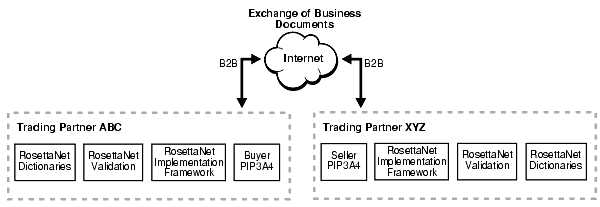
Partner Interface Processes (PIPs) serve as the functional building blocks of the RosettaNet standard, providing a structured framework for automated business communications. Understanding the organization and classification of these PIPs is essential for effective implementation and utilization within supply chain operations.
Overview of RosettaNet PIP clusters and segments
The RosettaNet consortium has organized its entire supply chain domain into a hierarchical structure of clusters, segments, and individual PIPs to create a manageable framework for business processes. This organizational system divides supply chain processes into logical categories based on business functions.
At the highest level, RosettaNet processes are divided into clusters, each representing a major business function. According to Microsoft’s documentation, there are eight primary clusters numbered from 0 to 7. Each cluster encompasses related business activities such as Order Management, Product Information, or Inventory Management.
These clusters are further subdivided into segments, which group related business processes. For instance, Cluster 3 (Order Management) contains segments like:
- 3A: Quote and Order Entry
- 3B: Transportation and Distribution
- 3C: Returns and Finance
The naming convention for PIPs follows a consistent pattern combining the cluster number and segment letter. For example, PIP 3A4 belongs to Cluster 3 (Order Management), Segment A (Quote and Order Entry), and is the fourth process within that segment.
Moreover, RosettaNet documentation indicates that each PIP specification includes three major components:
- Business Operational View (BOV): Defines business data entities and process flow
- Functional Service View (FSV): Specifies network component services and interactions
- Implementation Framework View (IFV): Details message formats and communication requirements
How to navigate the RosettaNet PIP directory
The RosettaNet PIP directory currently contains 134 PIPs organized across the eight clusters. Navigating this extensive catalog requires understanding the search parameters and organizational principles.
When searching for appropriate PIPs, professionals typically filter by:
- Standard (RosettaNet, CIDX, or PIDX)
- RNIF Version (1.1 or 2.0)
- PIP Code
- PIP Version
- Role (Initiator or Responder)
Advanced search capabilities also allow filtering by status, partner identity, and date ranges.
Furthermore, many implementation platforms enable saving search parameters for frequently used configurations, streamlining the process of locating specific PIPs for ongoing projects.
Mapping PIPs to business processes
Essentially, PIPs define standardized business processes between trading partners in a supply chain. Each PIP specifies:
- Trading partner business roles (e.g., buyer and seller)
- Business activities between the roles
- Type, content, and sequence of business documents
- Structure and constraints for interactions
RosettaNet PIPs follow specific design patterns that determine message flow.
- Asynchronous single-action activity (one business message with receipt acknowledgment)
- Asynchronous two-action activity (business messages and receipt acknowledgments from both partners)
- Synchronous one-action/two-action activity (requiring immediate response)
When mapping PIPs to business processes, organizations must first identify their specific business requirements. Subsequently, they can select PIPs from various segments to address specific business interface scenarios rather than being constrained by the rigid framework of clusters and segments.
For instance, a company implementing an order management system might utilize PIP 3A4 (Request Purchase Order) along with PIP 3B2 (Notify of Advance Shipment). This approach allows businesses to customize their RosettaNet implementation according to their workflow requirements.
RosettaNet aims fundamentally to align business processes of supply chain partners through these standardized PIPs, providing a common language for electronic business transactions and offering a foundation for integrating critical processes among global trading network partners.
Materials and Methods: Setting Up a RosettaNet-Compliant System
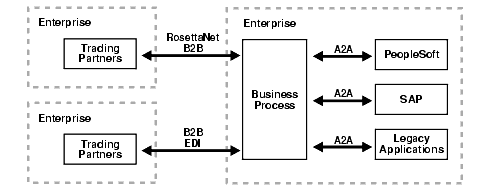
Implementing a RosettaNet-compliant system requires careful planning and adherence to specific technical requirements. Initially, organizations must understand both the infrastructure prerequisites and configuration elements that enable successful electronic document exchange between trading partners.
System prerequisites for RNIF 1.1 and 2.0
The RosettaNet Implementation Framework (RNIF) versions 1.1 and 2.0 have distinct technical requirements that must be addressed before deployment. RNIF functions as an open network application framework enabling business partners to collaboratively execute RosettaNet Partner Interface Processes (PIPs).
RNIF 2.0 introduced significant improvements over 1.1, primarily through added functionality in these areas:
- Encryption capabilities for secure transmission
- Enhanced attachment handling
- Support for synchronous transactions
- Addition of a delivery header component
It’s worth noting that RNIF 2.0 is not backward compatible with RNIF 1.1. Accordingly, when establishing a RosettaNet environment, you must decide which version to implement based on trading partner requirements.
For transport protocols, RNIF 1.1 exclusively supports secure HTTP, whereas RNIF 2.0 expands compatibility to multiple protocols, including SMTP. Furthermore, both versions rely on digital signatures for sender verification, but RNIF 2.0 adds comprehensive encryption that ensures transmitted messages can only be decrypted by the intended recipient.
RosettaNet XML schema and DTD setup
Setting up proper XML validation is vital for RosettaNet compliance. Each PIP includes a message guideline document with XML Document Type Definitions (DTDs) for specific messages. These DTDs define the structure and allowed elements within RosettaNet messages.
The validation process involves several critical components:
- Obtaining DTD schemas for all business messages used in your implementation
- Converting DTDs to XSD (XML Schema Definition) format if using modern integration tools
- Configuring grammar and schema validation using RosettaNet DTDs
Indeed, many integration platforms recommend using W3C XSD files instead of DTDs since tools like XQuery mapping (used for data transformations) predominantly support XSD schemas. If your PIP definitions aren’t available in XSD format, you’ll need to convert them using specialized tools like XML Spy Enterprise Edition.
Furthermore, RosettaNet PIP definitions contain detailed validation rules that exceed simple DTD validation. These rules are expressed in XML schema documents based on W3C XML Schema Definitions, ensuring stringent message validation.
Using DUNS numbers and MIME headers in the configuration
RosettaNet relies on DUNS (Dun & Bradstreet Universal Numbering System) numbers as unique identifiers for trading partners. When configuring a RosettaNet system, collecting DUNS information for both your organization and trading partners is a prerequisite step.
The DUNS number serves as a unique 9-13 character identification issued by Dun & Bradstreet Corporation and is mandatory in RosettaNet configurations. Meanwhile, MIME (Multipurpose Internet Mail Extensions) headers play an equally important role in message structure.
For MIME configuration, specific settings are required:
- MIME Type must be set to “Application”
- MIME Subtype must be set to “XML”
In RNIF 1.1 implementations, you may need to specifically add “MIME-Version:1.0” headers to outbound data. This can typically be accomplished through your RosettaNet-compliant software’s mailbox manager by modifying the command line from “Outbound” to “Outbound mime-version”.
Overall, establishing a RosettaNet-compliant system involves careful consideration of framework version compatibility, proper XML schema configuration, and attention to identification and header specifications throughout your implementation process.
Validating and Testing RosettaNet Messages in Real Environments
Validation stands as a critical pillar in successful RosettaNet implementation projects, determining whether messages adhere to the stringent requirements of the standard. Proper validation processes ensure smooth communication between trading partners, primarily by eliminating syntax and semantic errors before they cause transaction failures.
Grammar and schema validation using RosettaNet DTDs
RosettaNet employs a structured approach to message validation that follows a logical sequence of steps. When validating incoming messages, the system performs these operations in order:
- Grammar Validation – checks message structure against the Service Header DTD
- Sequence Validation – verifies the correct order of elements
- Schema Validation – validates against XML schemas
- Content Validation – examines business data values
It’s worth noting that a Service Header might appear valid according to DTD specifications even when the Service Content contains errors. Therefore, comprehensive validation requires examining both components. The RosettaNet PIP definitions contain significantly more stringent validation rules than those expressed within a standard XML Document Type Definition.
Many integration platforms recommend using W3C XSD files instead of DTDs since modern tools like XQuery mapping predominantly support XSD formats. During implementation, conversion tools like XML Spy Enterprise Edition can transform DTDs to XSD format when needed.
Validation serves primarily during the setup and configuration phases. Once you’ve eliminated invalid message generation issues, you may optionally disable validation checks to improve system performance. Still, this approach assumes that only valid messages are being sent between partners.
Receipt Acknowledgment vs General Exception Handling
The RosettaNet standard defines two distinct message categories: Business Actions (containing actual business content) and Business Signals (acknowledgments). Understanding their interaction is vital for proper exception handling.
A Receipt Acknowledgment represents a positive signal confirming receipt of a structurally and syntactically valid RosettaNet action message. This acknowledgment serves two purposes: tracking delivery reliability and providing non-repudiation of receipt.
In contrast, a General Exception functions as a negative signal indicating a processing exception has occurred. When systems encounter errors in message processing, this signal alerts trading partners about the failure.
Notably, Business Actions require acknowledgment, while Business Signals themselves are never acknowledged. RNIF 1.1 originally supported additional signal types including Receipt Acknowledgment Exception, Acceptance Acknowledgment, and Acceptance Acknowledgment Exception. However, RNIF 2.0 simplified this approach by retaining only Receipt Acknowledgment and General Exception signals.
Tools for testing RosettaNet XML messages
The RosettaNet Self-Test Kit (STK) provides essential resources for testing implementations, including W3C XSD schemas for selected PIPs. Accessible through the Developer Tools section on the RosettaNet Ready website, this toolkit helps developers validate their XML messages against official schemas.
For external validation, specialized applications like validate-rosetta-script test XML scripts against Rosetta’s internally generated XML Schema. These tools typically load the XML file, expand all including tags, replace script variables, and validate against the schema without executing the actual script.
Debugging tools can help troubleshoot common validation errors like “Element used but not declared” issues that sometimes occur during DTD validation. To assist with validation challenges, Oracle recommends turning on RosettaNet logging to capture detailed debug messages.
Results and Discussion: Real-World RosettaNet Example File Walkthrough

Examining real-world RosettaNet messages firsthand provides valuable insights into the practical implementation of this XML-based standard. Let’s analyze an actual PIP message structure to better understand how the theoretical framework translates into functional business communications.
Dissecting a PIP 3A4 Request Purchase Order message
PIP 3A4 (Request Purchase Order) exemplifies the asynchronous two-action activity design pattern, allowing a buyer to submit purchase orders to suppliers. This widely implemented PIP enables critical order management functionality across supply chains. The process flow typically begins when a buyer creates the PIP 3A4 Request in their purchasing system, then submits it to the supplier via an XML Gateway. Afterward, the supplier processes the request and sends a PIP 3A4 Confirmation back to the buyer.
The PIP 3A4 specification includes comprehensive documentation detailing everything from functional elements to specific field constraints. Each component has a prescribed structure that must be strictly followed to ensure proper processing. Most importantly, the DTD file included with the PIP defines the service-content message structure, while the message guideline document specifies element-level constraints.
Understanding the Service Header and Payload structure
A complete RosettaNet message consists of multiple XML structures specified by RosettaNet standards. The primary components include:
- Preamble Header – Identifies the message as a RosettaNet message
- Delivery Header – Identifies sender/receiver partners and provides the message identifier (present only in RNIF 2.0)
- Service Header – Contains process layer and transaction layer information
- Service Content (Payload) – Contains either an action or signal message
The Service Header helps identify crucial elements like the PIP, activity and action, sender information, recipient details, and timestamp. Furthermore, it indicates whether the message is for testing or production. Conversely, the Service Content varies based on the specific business transaction but maintains a consistent structure defined by the PIP’s DTD or schema.
One notable difference between RNIF versions relates to attachments. In RNIF 2.0, attachments are supported through separate MIME parts in the MIME multipart/related entity. Nevertheless, these attachments remain optional and exist only in RosettaNet Action messages, not in signal messages.
Common errors in RosettaNet example files and how to fix them
Despite careful implementation, several issues frequently arise when working with RosettaNet messages. Among the most common is the “broken pipe” error during the transmission of large documents. This typically occurs when the connection times out during file transfer. To resolve this, consider increasing timeout settings or implementing file chunking mechanisms.
Another frequent issue involves XML validation failures like “Element used but not declared” errors. These generally stem from mismatches between the XML document and its corresponding DTD. The solution lies in ensuring strict adherence to the PIP specification and validating messages against the official RosettaNet DTDs before transmission.
File path errors can also disrupt processing, particularly when systems expect files in specific locations. For instance, errors like “FileNotFoundException” indicate that the system cannot locate necessary files. To address this, verify all file paths and ensure proper directory permissions are configured.
For successful RosettaNet implementations, thorough testing and validation remain essential, particularly when dealing with critical business processes like purchase order requests.
Limitations and Integration Challenges in RosettaNet Deployment
Despite its structured framework and widespread adoption, RosettaNet implementation presents several technical challenges that organizations must address for successful deployment.
Backward compatibility issues between RNIF 1.1 and 2.0
One fundamental limitation of RosettaNet is that “RNIF 2.0 is not backward compatible with RNIF 1.1”. This incompatibility creates significant hurdles when trading partners use different RNIF versions. The frameworks differ substantially in how they handle:
- Attachment support (present in 2.0, absent in 1.1)
- SMIME envelope structure
- Delivery header (added in 2.0)
- MIME packaging methodology
Yet another challenge arises with certain features. For instance, “BTARN does not support attachments and synchronous transactions in RNIF 1.1”. Organizations must hence carefully plan version selection based on trading partner capabilities and transaction requirements.
Limitations in RosettaNet XML schema validation
RosettaNet XML validation presents several technical constraints. Primarily, “This application merely verifies that the input script is valid according to the XSD”, meaning validation tools often cannot detect mutual exclusivity issues or parse-function failures.
Schema validation challenges likewise extend to specific data types. Certainly, “For schema element of type ‘string’ validation works fine, but for other datatypes, especially Decimal, the validate service generates the error”. These validation errors typically manifest as issues like “errorCode: DT-006” or “errorMessage:[B2BCORE.0082.9489]”, creating implementation bottlenecks.
Additionally, organizations may encounter namespace errors like “UNP.SCON.VALERR: A failure occurred while validating the service content” or “SerializableAttribute does not exist in the class or namespace”, requiring schema deployment verification.
Challenges in integrating RosettaNet with REST APIs
Presently, connecting RosettaNet with modern REST APIs creates additional complications. “Implementing and maintaining RosettaNet integrations can be challenging due to the complexity of the standard and the various data formats used by different partners”.
Integration platforms must provide robust capabilities including:
- Private API keys for restricting access
- Nameable endpoints for connecting diverse datasets
- API lifecycle management tools
- Proper data mapping between XML and JSON formats
Furthermore, “Two-way SSL connections in the inbound (trigger) direction are not supported”, limiting security options for certain integration scenarios.
List of RosettaNet PIPs Messages
| ID | Message |
| 3A1 | Request Quote |
| 3A2 | Request Price and Availability |
| 3A3 | Request Shopping Cart Transfer |
| 3A4 | Request Purchase Order |
| 3A5 | Query Order Status |
| 3A6 | Distribute Order Status |
| 3A7 | Notify of Purchase Order Update |
| 3A8 | Request Purchase Order Change |
| 3A9 | Request Purchase Order Cancellation |
| 3A10 | Notify of Quote Acknowledgement |
| 3A13 | Notify of Purchase Order Information |
| 3A14 | Distribute Planned Order |
| 3B1 | Distribute Transportation Projection |
| 3B2 | Notify of Advance Shipment |
| 3B3 | Distribute Shipment Status |
| 3B4 | Query Shipment Status |
| 3B5 | Request Shipment Change |
| 3B6 | Notify of Shipments Tendered |
| 3B11 | Notify of Shipping Order |
| 3B12 | Request Shipping Order |
| 3B13 | Notify of Shipping Order Confirmation |
| 3B14 | Request Shipping Order Cancellation |
| 3B18 | Notify of Shipment Documentation |
| 3C1 | Return Product |
| 3C2 | Request Financing Approval |
| 3C3 | Notify of Invoice |
| 3C4 | Notify of Invoice Reject |
| 3C5 | Notify of Billing Statement |
| 3C6 | Notify of Remittance Advice |
| 3C7 | Notify of Self-Billing Invoice |
Conclusion
RosettaNet stands as a powerful EDI standard that transforms supply chain communications through structured XML-based exchanges. Organizations implementing RosettaNet experience significant improvements in transaction processing times, moving from weeks to minutes while ensuring reliable data exchange between trading partners.
Though RosettaNet implementation presents technical challenges, particularly regarding version compatibility and API integration, its benefits outweigh these hurdles. Companies achieve streamlined operations through standardized Partner Interface Processes (PIPs), comprehensive validation frameworks, and reliable message delivery systems.
The standard continues evolving, addressing modern business needs through enhanced security features and improved integration capabilities. Support for multiple transport protocols and robust validation mechanisms ensures reliable B2B communications across global supply chains.
Businesses seeking reliable EDI solutions can switch to Commport Integrated EDI today, supporting various EDI standards including X12, EDIFACT, RosettaNet, EANCOM and more. This comprehensive platform helps organizations overcome implementation challenges while maintaining compliance with industry standards.
RosettaNet’s future looks promising as more organizations recognize its value in standardizing business processes and enabling efficient supply chain operations. Success stories from major technology companies demonstrate its effectiveness in reducing processing times and improving operational efficiency across diverse industries.
Commport Integrated EDI Solution
Need Help? Download: Commport's EDI Buyers Guide
Unlock the full potential of your supply chain with our comprehensive EDI Buyer's Guide — your first step towards seamless, efficient, and error-free transactions
Frequently Asked Questions
RosettaNet is an XML-based standard that defines both e-commerce documents and exchange protocols, while traditional EDI standards uses text-based formats. RosettaNet focuses more on process modeling and provides faster response times compared to other EDI standards batch processing. It also includes business and technical dictionaries that EDI lacks.
RosettaNet streamlines supply chain communications by providing standardized Partner Interface Processes (PIPs) for common business transactions. It enables near-time processing, offers machine-processable information, and establishes a common e-business language. This results in significant time savings, with some companies reducing process times from weeks to minutes.
A complete RosettaNet message consists of multiple XML structures: the Preamble Header (identifies the message as RosettaNet), Delivery Header (identifies sender/receiver and message ID), Service Header (contains process and transaction information), and Service Content (contains the actual business data or signal).
RosettaNet standards are widely adopted in high-tech sectors, particularly in electronic components manufacturing, semiconductor manufacturing, information technology, telecommunications, and logistics industries. It has gained significant acceptance in the United States and Asia.
Common challenges include backward compatibility issues between RNIF 1.1 and 2.0, limitations in XML schema validation for certain data types, and difficulties in integrating RosettaNet with modern REST APIs. Additionally, organizations may face “broken pipe” errors during large document transmissions and XML validation failures due to mismatches between documents and DTDs.

